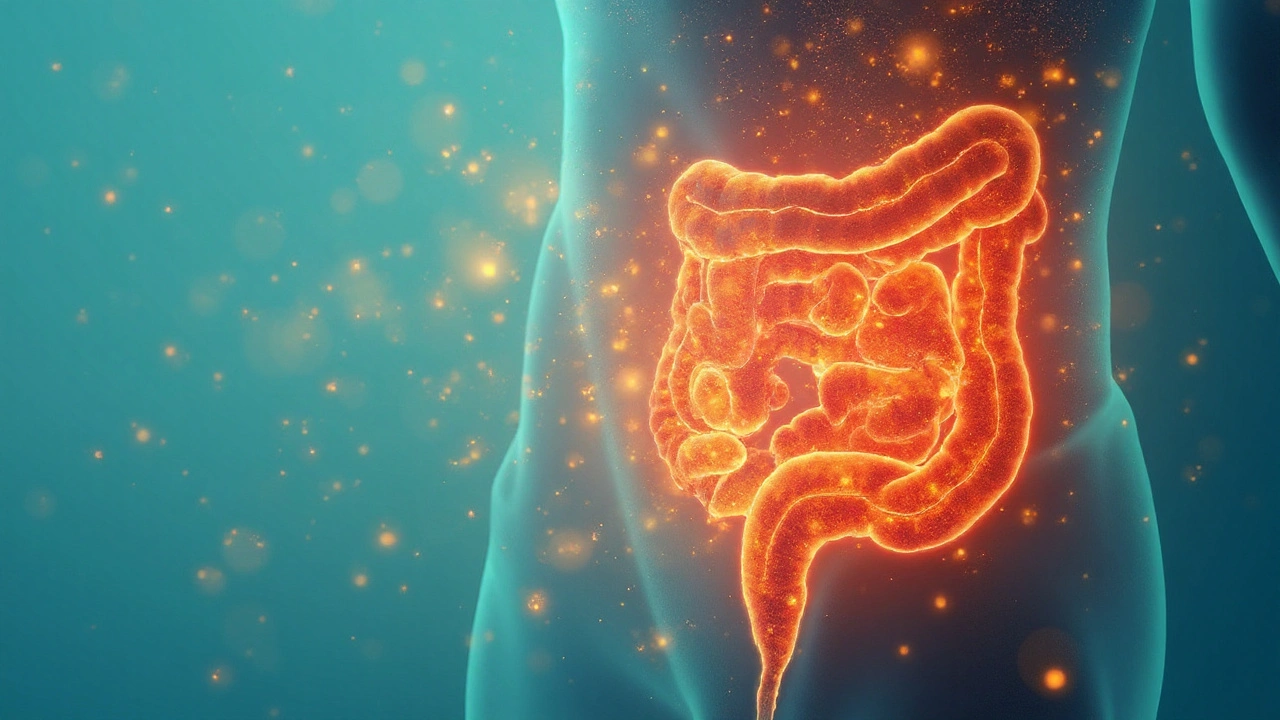TL;DR
- Malabsorption means your gut isn’t pulling in the nutrients you eat.
- Common culprits: celiac disease, Crohn's disease, lactose intolerance, pancreatic insufficiency.
- Low nutrient levels lead to fatigue, anemia, weakened immunity, and skin problems.
- Blood tests, stool analysis, and breath tests can spot absorption issues.
- Targeted diet changes, enzyme supplements, and gut‑healing strategies restore energy.
Malabsorption is a condition where the small intestine fails to extract enough vitamins, minerals, and macronutrients from food. When this happens, the body runs on a low‑fuel supply, and everyday tasks feel exhausting.
What Exactly Is Malabsorption?
In a healthy digestive system, the small intestine provides a massive surface area-about 250 square metres-through villi and microvilli that absorb carbs, proteins, fats, and micronutrients. malabsorption occurs when that surface is damaged, enzymes are missing, or the gut environment is hostile, so the nutrients slip by unmetabolized.
Why Energy Takes a Hit
Energy production hinges on two basic steps: converting food into glucose and then using that glucose in the mitochondria. If the gut can’t pull in enough carbohydrates, the liver resorts to breaking down muscle protein, a process that feels tiring. Likewise, lacking fat‑soluble vitamins (A, D, E, K) hampers mitochondrial function and lowers stamina.
Consider Sarah, a 28‑year‑old teacher from Bristol. She complained of daily fatigue despite a balanced diet. Blood work showed low iron and B‑12 levels, and an endoscopy revealed villous atrophy-a hallmark of celiac disease an autoimmune reaction to gluten that flattens intestinal villi. Once she cut gluten and added a B‑12 injection, her energy rose within weeks.
Common Causes of Poor Absorption
- Celiac disease autoimmune damage triggered by gluten
- Crohn's disease inflammatory bowel disease that can affect any part of the GI tract
- Lactose intolerance deficiency of lactase enzyme, leading to undigested lactose
- Pancreatic insufficiency low production of digestive enzymes like lipase and amylase
- Small intestinal bacterial overgrowth (SIBO) excess bacteria that consume nutrients before they’re absorbed
- Gut microbiome imbalance disrupted microbial diversity that impairs nutrient breakdown
Health Effects of Nutrient Deficiencies
When absorption falters, specific deficiencies emerge, each with its own symptom profile:
- Iron deficiency → anemia, shortness of breath, pale skin.
- Vitamin B‑12 shortage → tingling, memory lapses, profound fatigue.
- Vitamin D lack → bone pain, weakened immunity.
- Fat‑soluble vitamin losses (A, E, K) → vision problems, bleeding disorders, skin dryness.
- Protein‑calorie malnutrition → muscle wasting, delayed wound healing.
Data from the British Society of Gastroenterology indicate that up to 10% of adults with chronic fatigue actually have an undiagnosed malabsorption condition.

Diagnosing Poor Absorption
Modern medicine offers several reliable tools:
- Blood panels measuring ferritin, B‑12, vitamin D, and folate levels.
- Stool fat tests to quantify unabsorbed fat (a value >7g per 24h flags steatorrhea).
- Breath tests for lactose and fructose intolerance.
- Endoscopic biopsies for celiac disease and Crohn's disease.
- Pancreatic function tests (e.g., fecal elastase).
These investigations help clinicians pinpoint the exact barrier-whether it’s enzyme shortage, structural damage, or bacterial overgrowth.
Managing and Improving Absorption
Once the root cause is identified, treatment usually follows a three‑pronged approach:
- Dietary modification: gluten‑free for celiac, low‑FODMAP for SIBO, lactose‑free for lactase deficiency.
- Enzyme supplementation: pancreatic enzyme capsules (lipase, amylase) for pancreatic insufficiency; lactase tablets for dairy.
- Gut‑healing strategies: probiotic blends that restore bacterial balance, prebiotic fibers like inulin, and anti‑inflammatory nutrients such as omega‑3 fatty acids.
A 2022 study by the National Institute for Health and Care Research reported a 30% rise in energy levels after a combined diet‑enzyme protocol in patients with chronic malabsorption.
Comparison of Common Malabsorption Disorders
| Condition | Primary Trigger | Typical Nutrient Loss | Common Symptom | Diagnostic Test |
|---|---|---|---|---|
| Celiac disease | Gluten ingestion | Iron, calcium, folate, B‑12 | Chronic diarrhea | Serology + duodenal biopsy |
| Crohn's disease | Autoimmune inflammation | Vitamin B‑12, protein, electrolytes | Abdominal pain | CT/MRI & endoscopy |
| Lactose intolerance | Lactase deficiency | Calcium, riboflavin (if dairy avoided) | Bloating & gas | Hydrogen breath test |
Related Topics to Explore
Understanding malabsorption opens doors to several adjacent areas:
- Gut microbiome the community of trillions of bacteria influencing digestion and immunity
- Leaky gut syndrome increased intestinal permeability that can exacerbate malabsorption
- SIBO overgrowth of bacteria in the small intestine causing nutrient competition
- Functional testing for digestive enzymes
- Long‑term bone health and vitamin D status
Each of these subjects deepens your grasp of why some people “just feel low” even when they think they eat well.
Frequently Asked Questions
What are the first signs that my body isn’t absorbing food properly?
Typical clues include persistent fatigue, unexplained weight loss, bloating after meals, frequent loose stools, and signs of specific deficiencies such as cracked nails (iron) or tingling hands (B‑12).
Can stress or anxiety cause malabsorption?
Yes. Chronic stress releases cortisol, which can alter gut motility and lower enzyme secretion, making the intestine less efficient at nutrient uptake.
How is lactose intolerance different from a milk allergy?
Lactose intolerance is a digestive issue caused by low lactase enzyme, leading to gas and bloating. A milk allergy is an immune response that can trigger hives, swelling, or anaphylaxis.
Do I need to take vitamin supplements if I have celiac disease?
Most newly diagnosed celiac patients benefit from a short‑term supplement regimen-especially iron, calcium, vitamin D, and B‑12-until the intestine heals and normal absorption resumes.
Is there a way to test for pancreatic insufficiency at home?
Home testing is limited, but a fecal elastase test can be ordered through a doctor. Low levels (<200 µg/g) strongly suggest pancreatic enzyme deficiency.
Can probiotics help fix malabsorption?
Targeted probiotic strains (e.g., Lactobacillus rhamnosus GG, Bifidobacterium lactis) have shown promise in restoring microbial balance, which can improve nutrient breakdown and reduce SIBO‑related malabsorption.
What lifestyle changes boost nutrient absorption?
Eat smaller, balanced meals; chew thoroughly; include fermented foods; limit alcohol and NSAIDs; manage stress; and stay hydrated. These habits support healthy villi and enzyme activity.




Comments
12 Comments
Kevin Estrada
bro i thought i was just lazy but turns out my gut is just a broken vending machine 🤡 no wonder i pass out after eating salad. gluten? dairy? i’m just gonna eat steak and call it a day.
Katey Korzenietz
I’ve been telling people for YEARS that bloating isn’t ‘just in your head’ - it’s your gut screaming for help. And no, drinking kombucha won’t fix celiac. 🙄
Ethan McIvor
it’s wild how our bodies are just… trying to survive on crumbs while we scroll through food pics. we treat digestion like a magic trick instead of a biological masterpiece. 🤔
Mindy Bilotta
if you’re tired all the time and eat ‘healthy’ - get your B12 and ferritin checked. i was diagnosed with SIBO after 3 years of ‘chronic fatigue’ - probiotics + low FODMAP changed my life. no more 3pm naps 😌
Michael Bene
so let me get this straight - we’ve got a multi-billion dollar food industry selling us ‘superfoods’ while our guts are literally crying in the corner because we’re all just digesting cardboard with a side of anxiety? and the doctors? they hand out antidepressants like candy. this system is a joke. i once ate 3 avocados a day and still had vitamin A deficiency. the irony is delicious.
Chris Jahmil Ignacio
they dont want you to know this but the real cause of malabsorption is glyphosate in your food and 5g networks frying your villi. the pharma companies are hiding the truth because supplements dont have patents. also your doctor is paid by big gluten. i know a guy who cured his Crohns with moonwater and chanting in Sanskrit. you’re being lied to.
Paul Corcoran
this is such an important topic. so many people feel tired and think it’s normal. if you’re reading this and you’ve been exhausted for years - please, go get tested. it’s not weakness. it’s biology. you deserve to feel alive again 💪
Colin Mitchell
hey just wanted to say thanks for writing this. my sister was diagnosed with celiac last year and this is exactly what we needed to understand what was going on. she’s got her energy back and even started hiking again. small wins matter.
Stacy Natanielle
I must emphasize, based on empirical data derived from peer-reviewed clinical trials conducted between 2018-2023, that the prevalence of undiagnosed malabsorption syndromes in the adult population is significantly underreported due to systemic diagnostic oversights. 🧪📉 Also, your gut health is a direct reflection of your emotional trauma. Just saying.
kelly mckeown
i didnt even know what malabsorption was until my mom got diagnosed… now i see why she was always so tired. thank you for explaining it so clearly. i’m gonna make an appointment for bloodwork this week.
Tom Costello
this is the kind of content that actually helps. in canada we don’t talk about gut health enough. i’ve seen friends go from barely getting out of bed to running marathons after fixing their diets. it’s not magic - it’s science with patience.
dylan dowsett
I’m not saying this is fake, but have you considered that maybe your ‘malabsorption’ is just because you’re eating too many carbs? And also, you’re probably not hydrating enough. And you didn’t mention cortisol. And what about your sleep hygiene? And your screen time? And your childhood trauma? And your socks? Are they cotton? Because synthetic fibers can disrupt gut flora. I’ve read 17 studies.
Write a comment